eCommerce: Shopping Trends
Artificial Intelligence (AI) in eCommerce: U.S. Consumer Expectations, Concerns & Awareness
Artificial intelligence shapes online shopping with tools that enhance the customer experience, analyze data, and manage the supply chain. But how aware are U.S. consumers of AI features in eCommerce? ECDB discusses consumer expectations for the benefits and pitfalls of increased AI adoption in online shopping.
Article by Nadine Koutsou-Wehling | February 21, 2024Download
Coming soon
Share

AI in eCommerce: Key Insights
U.S. Consumers Have Moderate to Neutral Expectations: Over a third of the 2023 Top Shop survey participants in the U.S. anticipate AI technology to moderately enhance their online shopping experiences. While gender and age influence these expectations, the correlations aren't strictly linear.
Privacy and Data Security Concerns Most Common: Across demographics, the primary concern refers to a violation of privacy or data security through AI in online shopping. Less prevalent are worries about losing human touch in customer service, the accuracy of predictions, or increased impulse buying.
Most Users Are Aware of Recommendations and Chatbots: Consumer awareness of AI in eCommerce is highest for personalized product recommendations, customer service chatbots and individual discounts. Demographics play a role, but due to overall low familiarity with features, attitudes are subject to personal viewpoints and experiences.
Artificial intelligence (AI) has become the buzzword of the past few years and with the launch of chatbots from OpenAI and Google, the AI phenomenon has been made accessible to the public on a large scale.
What AI looks like in eCommerce: More personalized offers tailored to individual shopping habits and preferences, better visualization of how products are presented to users, and enhanced customer interaction through chatbots.
eCommerce sites are using AI to enhance the online shopping experience and gather consumer data for actionable understandings of shopper behavior. Consumers in turn see both the positive and negative implications of AI in eCommerce. But are they also aware of the AI features that are being used?
To assess online shoppers’ attitudes toward artificial intelligence in eCommerce, ECDB examined the results of Statista’s 2023 Top Shop survey in the U.S. and how demographics relate to these perspectives.
AI Solutions in eCommerce: Most U.S. Users Expect Small Improvements
In a first examination, we show how U.S. consumers in general tend to feel about the promised benefits of AI for eCommerce, before moving on to more detailed assessments by demographic.
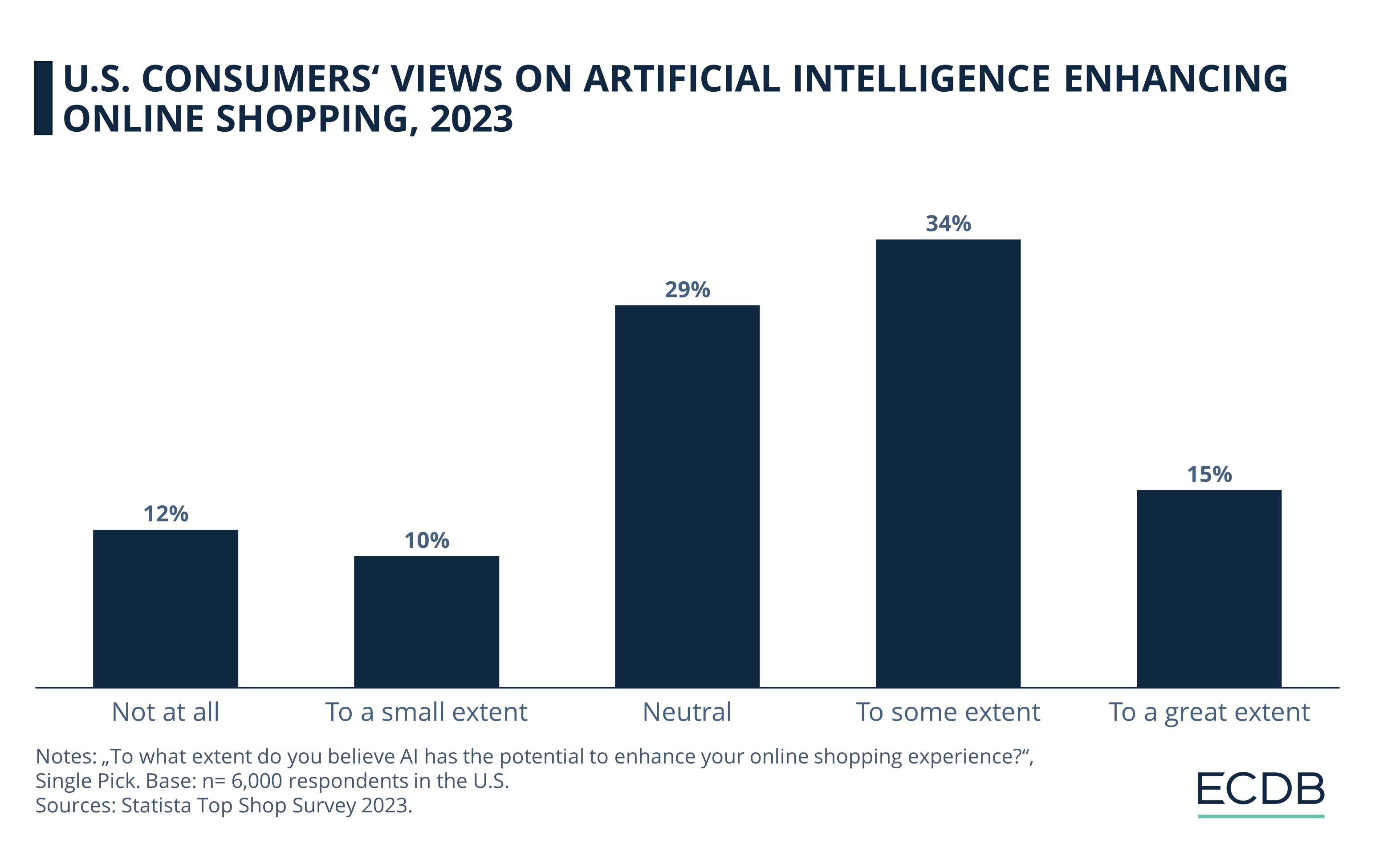
Among all respondents to the U.S. Top Shop survey, the lowest proportions of consumers said they did not believe artificial intelligence could improve their shopping experience at all (12%) or only to a small extent (10%).
In fact, the majority of respondents were either neutral (29%) or thought AI could improve their shopping experience to some extent (34%). Only a smaller share, 15% of U.S. consumers, expected AI to greatly improve their online shopping experience.
Looking at demographics: How do consumer preferences change from a gender perspective?
Gender: Female Users Tend to Be More Skeptical of Improvements
When these responses are sorted by respondents' gender, we see that female consumers tend to be more skeptical of the promised benefits of AI for eCommerce than male users:
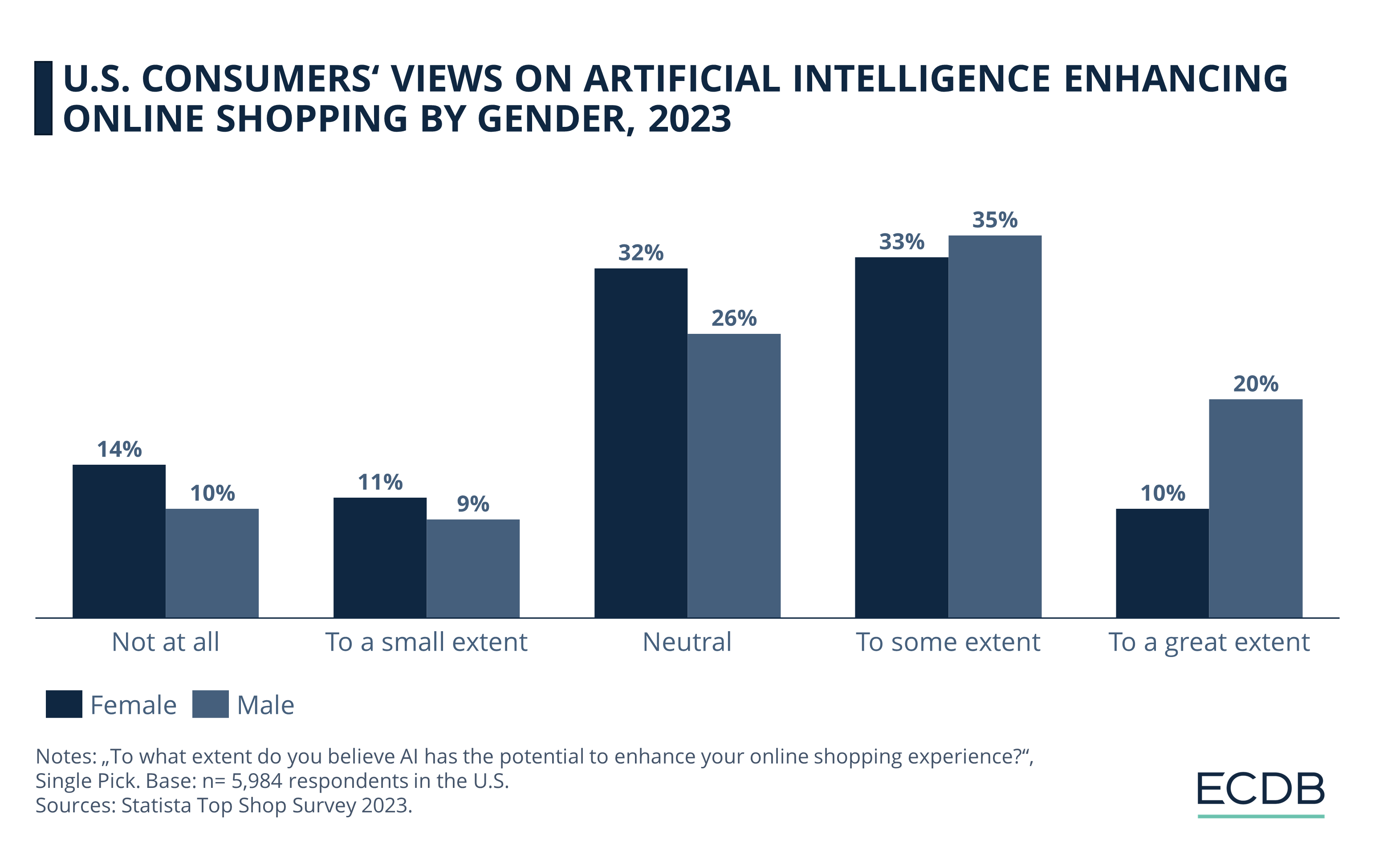
More specifically, female respondents are more likely than their male counterparts to say they expect no improvement at all (14% female vs 10% male), a small improvement (11% female vs 9% male), or a neutral improvement (32% female vs 26% male).
On the other hand, male users are slightly more likely than female respondents to see moderate improvements from artificial intelligence (35% male vs 33% female). Notably, the "to some extent" option was the most frequently selected by respondents of all genders. However, among female users, being neutral about potential improvements was almost as common as selecting "to some extent”.
Another remarkable gender difference is in the expectation of large improvements, where 20% of male respondents agreed, compared to only 10% of female users.
How does age influence consumer attitudes toward AI benefits in online shopping?
Age: Younger Shoppers More Positive About Using AI in eCommerce
A distribution by age group shows that expectations of improvements from AI are largely negatively correlated with age, but the relation is not strictly linear.
The most notable pattern that emerged is that U.S. consumers up to age 54 are most likely to expect improvements “to some extent”, while respondents over age 54 tend to be mostly neutral about any expected benefits of AI to their shopping experience.
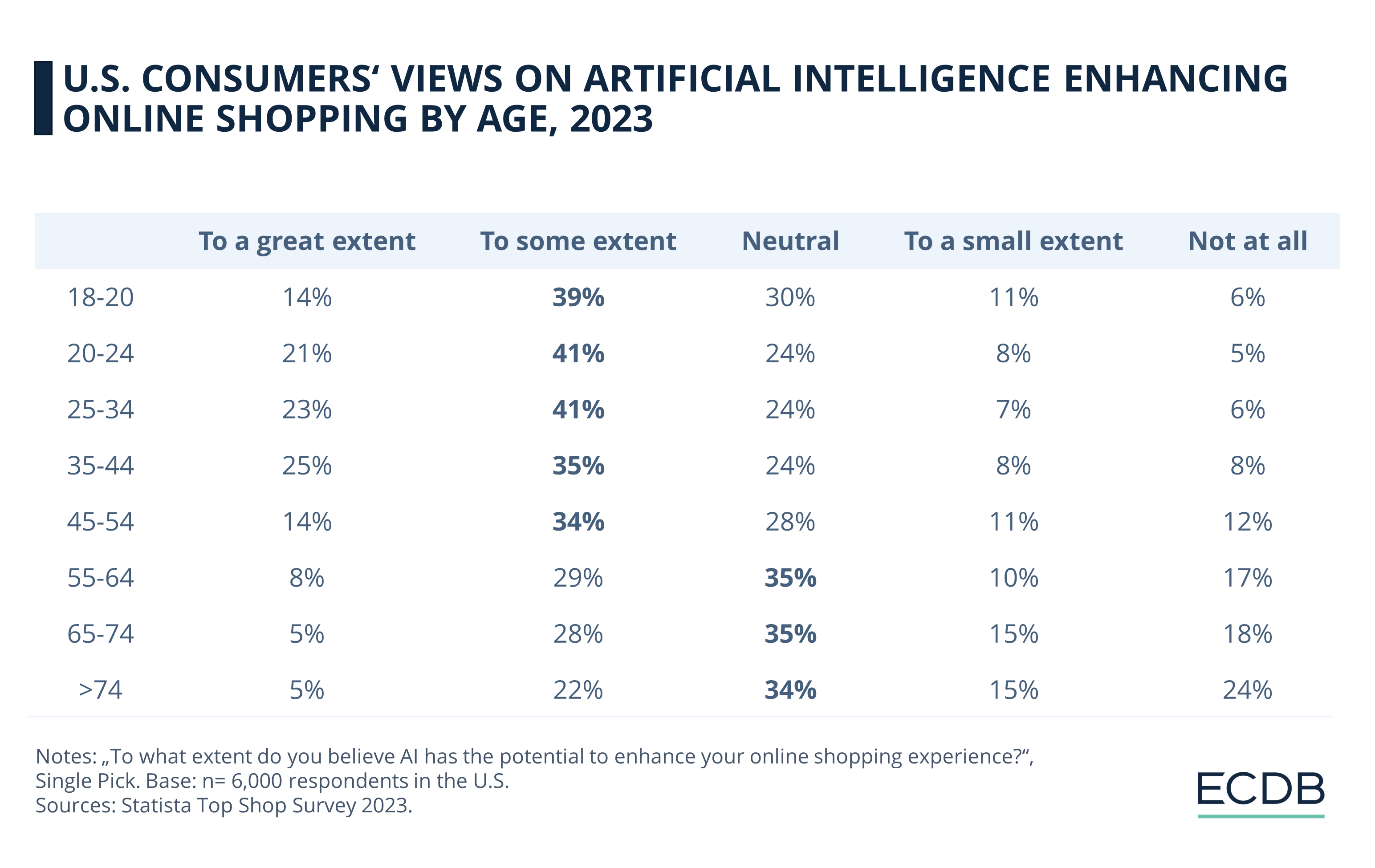
Moreover, U.S. consumers up to 54 years are more likely to expect improvements “to a great extent”, than older users. Respondents to the Top Shop survey over the age of 54 were more likely to expect small improvement or no improvement at all.
While it can be said that younger U.S. consumers tend to expect more benefits from artificial intelligence than those older than 54 years, these preferences are not clear and linear, leaving room for individual attitudes and viewpoints.
Learn About Our ECDB Benchmarks
Benefits of Using AI More Prevalent in Households With at Least 3 People
In general, expectations for improvements from artificial intelligence are positively correlated with respondents’ household size.
The survey data shows that single-person households are most likely to be neutral about expected improvements in online purchases, while consumers living in households with at least 3 people are more likely to expect moderate improvements in their online shopping experience.
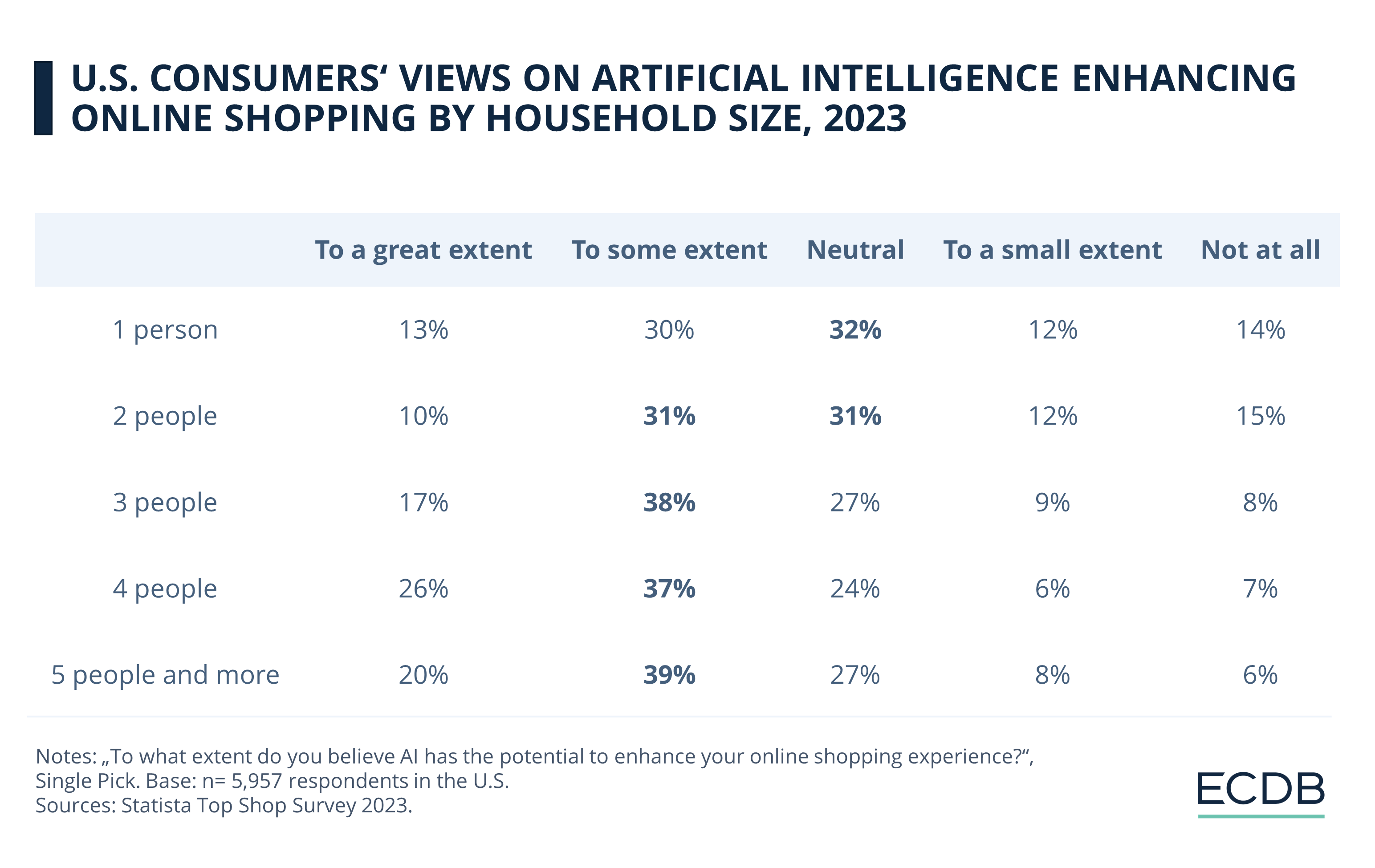
Similarly, U.S. users living in households of 4 or more people are most likely to expect improvements “to a great extent”, while those living in single-person or two-person households are most inclined to expect benefits “to a small extent” or “not at all”.
As with the previous variables, however, it is important to note that the relation is not entirely linear and shows individual variations.
Privacy and Data Security the Most Common Concern
A general look across all survey respondents indicates the most common concerns consumers have about the impact of AI on online shopping.
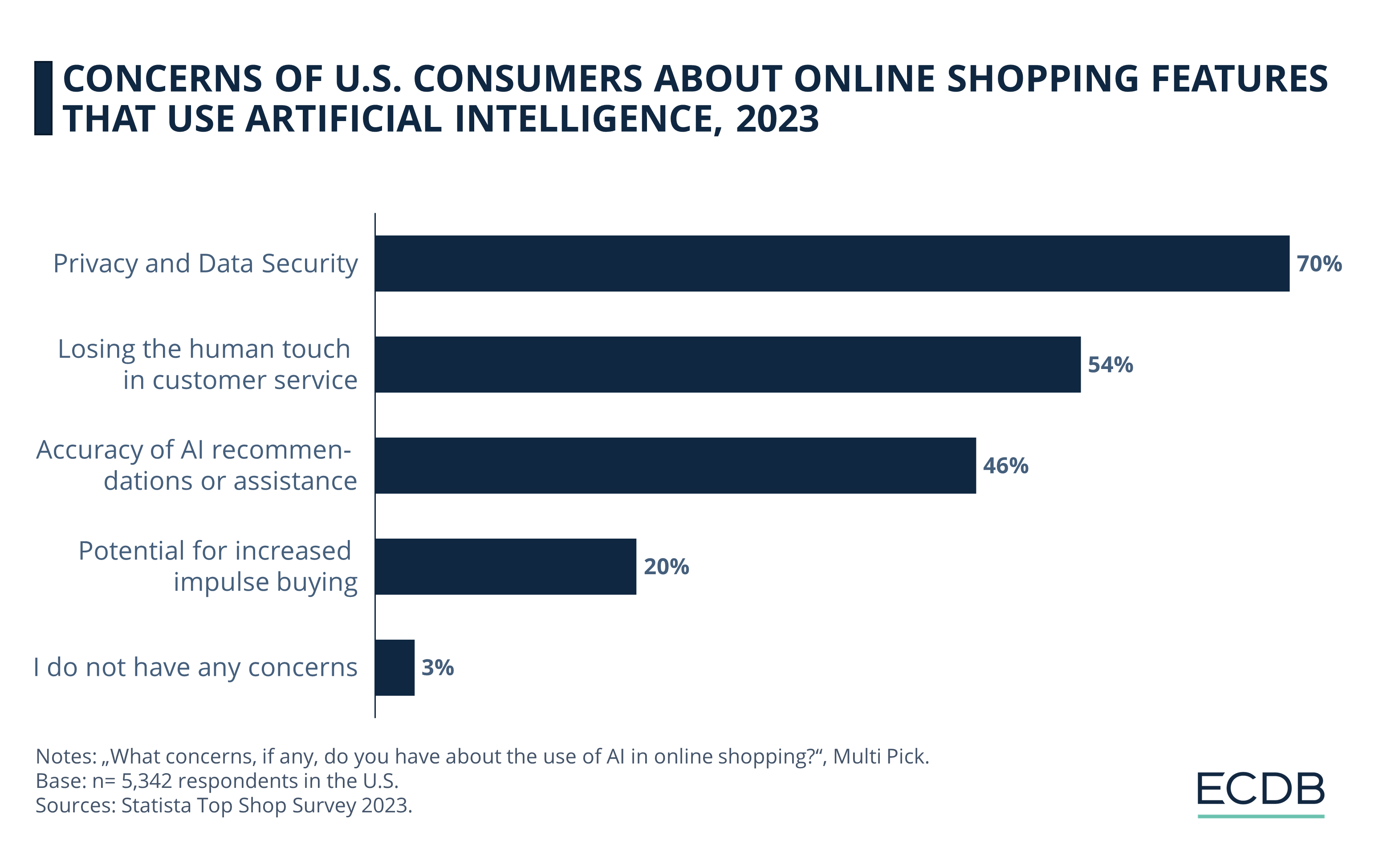
Most online shoppers cite privacy and data security concerns, with 70% of respondents opting for this answer. As machine learning algorithms are adept at connecting data points and processing large amounts of information, consumers are apprehensive about how this will affect the handling of their personal information.
The second most common worry pertains to the loss of human touch in customer service. More than half, that is 54% of U.S. users agree. Adding AI capabilities to customer service can be beneficial in terms of the volume of requests a machine can handle around the clock, but consumers are apparently worrying about the quality of interactions and AI's ability to handle individualized, more complex issues.
In third place are the 46% of U.S. consumers who doubt the accuracy of AI recommendations or assistance. 20% of users fear an increased potential for impulse buying, as AI can make product discovery much easier.
Only 3% of U.S. users have no concerns about the negative impact that AI integration could have on the shopping experience.
Let’s see how gender affects the results.
Gender Differences: Privacy Concerns vs. Accuracy Doubts
An examination by respondent gender reveals some trends, albeit with no massive disparities observed between male and female consumers.
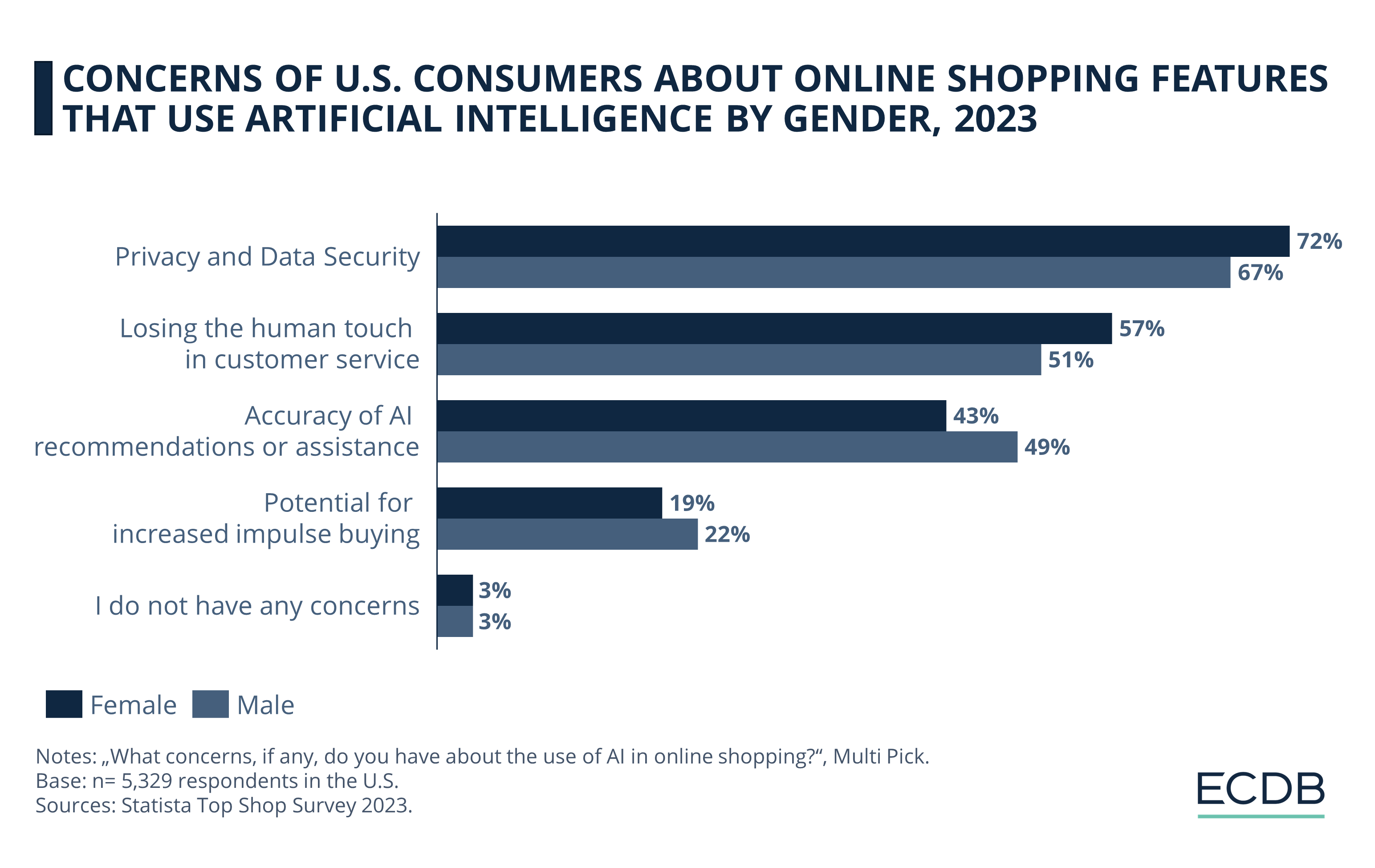
Notably, female respondents are more likely than their male counterparts to express privacy and data security concerns (72% female agreement vs. 67% male agreement) and be worried about the loss of human touch in customer service (57% female agreement vs. 51% male agreement).
On the other hand, male users tend to doubt the accuracy of AI recommendations more (49% male agreement vs. 43% female agreement). Male consumers are also more likely to be worried about the potential for increased impulse buying through AI features, at 22%, compared to 19% of female users.
A commonality between male and female attitudes is found in the final category: no concerns, which represents a 3% share on each side.
Privacy Concerns Remain Most Relevant Across Age Groups
Sorting the top consumer concerns by age group demonstrates both consistency in some respects and divergence in others:
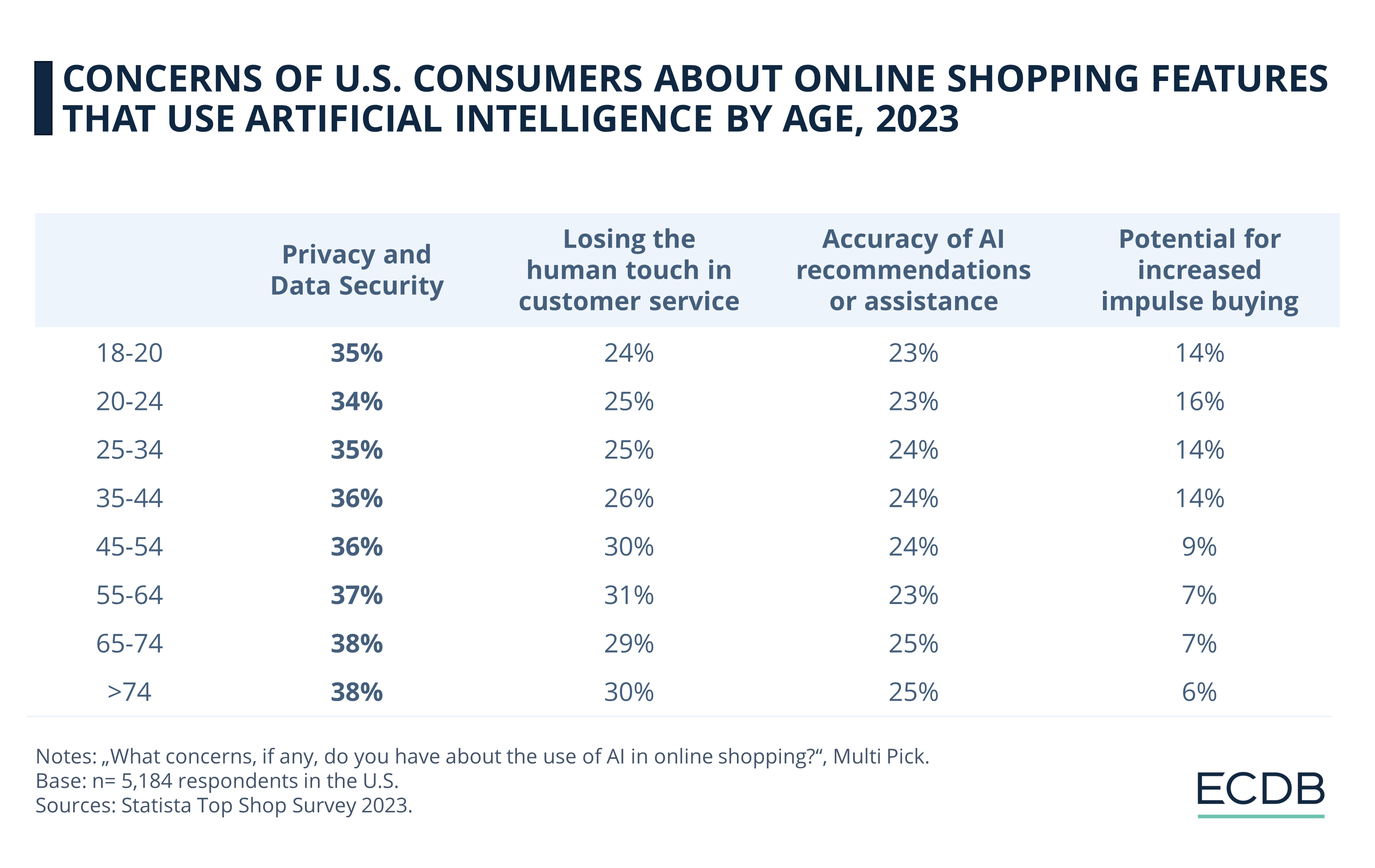
Across all age groups, concerns about privacy and data security emerge as the top response, with a moderately increasing tendency to select this answer as respondents get older. While U.S. consumers aged 18 to 20 and 25 to 34 are the second least likely to have these concerns at 35%, this tendency drops to 34% for respondents aged 20 to 24. Respondents between the ages of 35 and 54 share privacy concerns at a rate of 36%, while those over 65 years are the most concerned, at 38%.
In fact, the two aspects “losing human touch in customer service” and “accuracy of AI recommendations” are also both positively correlated with age, meaning that older users are more inclined to express these concerns. While this correlation is more pronounced for the loss of human touch, with 25% of 20- to 43-year-olds and around 30% of those over 45 agreeing, the accuracy of AI recommendations shows little variation between age groups.
More precisely, 23% of users between the ages of 18 and 24 doubt the accuracy of AI-powered services, while 25% of consumers over the age of 65 do so. However, neither of the previous two aspects is entirely linear, with slight irregularities in the correlation.
The final issue that U.S. consumers see with AI in eCommerce is the potential for increased impulse buying. Unlike the previous responses, there is a negative correlation with age. Although not strictly linear, there is a marked decline in agreement starting at the age of 45.
More Than Half of U.S. Shoppers Are Aware of AI Product Recommendations
AI has played a role in streamlining eCommerce operations long before the recent launch of chatbots and broader public awareness of AI technologies. Early AI implementations pertaining to personalized product recommendations, predictive inventory management, automated customer service for routine inquiries, fraud detection, and pricing algorithms laid the foundation for more advanced applications that are currently being introduced.
U.S. users were asked to identify AI-powered features they are aware of when shopping online:
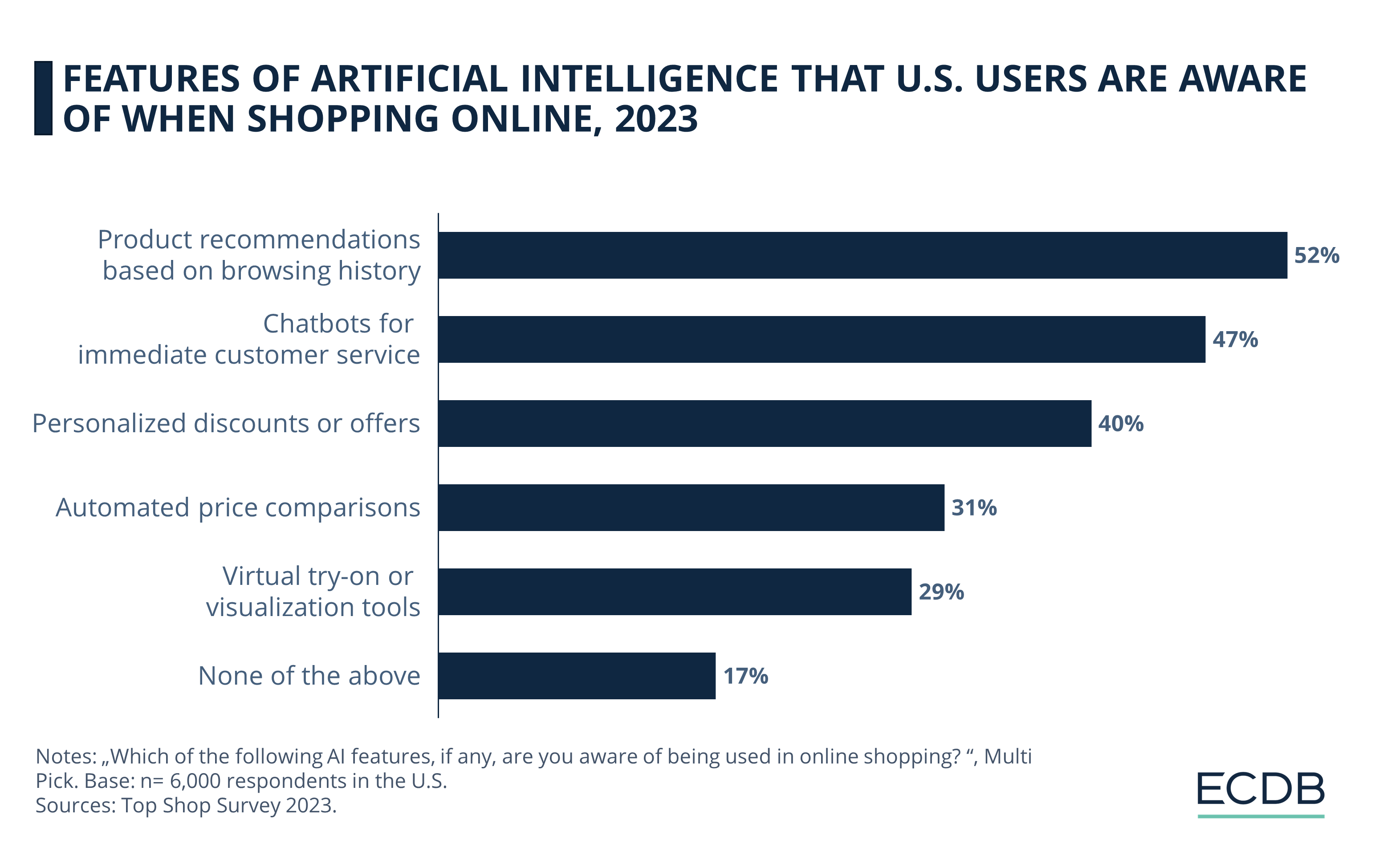
Most U.S. consumers are aware of personalized product recommendations (52%) generated by AI based on previous searches, purchases, and preference patterns. This is followed by chatbots for round-the-clock customer queries (47%), which enable a more personalized approach for immediate responses through machine learning.
In third place, 40% of consumers identified personalized discounts or offers as an AI feature they have encountered while shopping online. Fewer online shoppers are aware of automated price comparisons (31%) and virtual try-on or visualization tools (29%).
Nevertheless, there is a substantial 17% of U.S. consumers who are unaware of any of the above features; showing that there is still a high level of unfamiliarity with AI features.
Awareness of AI Features Largely Balanced Across Genders
Most of the AI features are equally well known to male and female consumers in the U.S.: Slightly more female users (53%) than male users (52%) are aware of personalized product recommendations and personalized discounts and offers (40% of female users vs. 39% of male users). While more female shoppers (30%) than male consumers (27%) have encountered virtual try-ons and visualizations in eCommerce, there are also more female users (18%) than male users (16%) who say they are not aware of any AI feature.
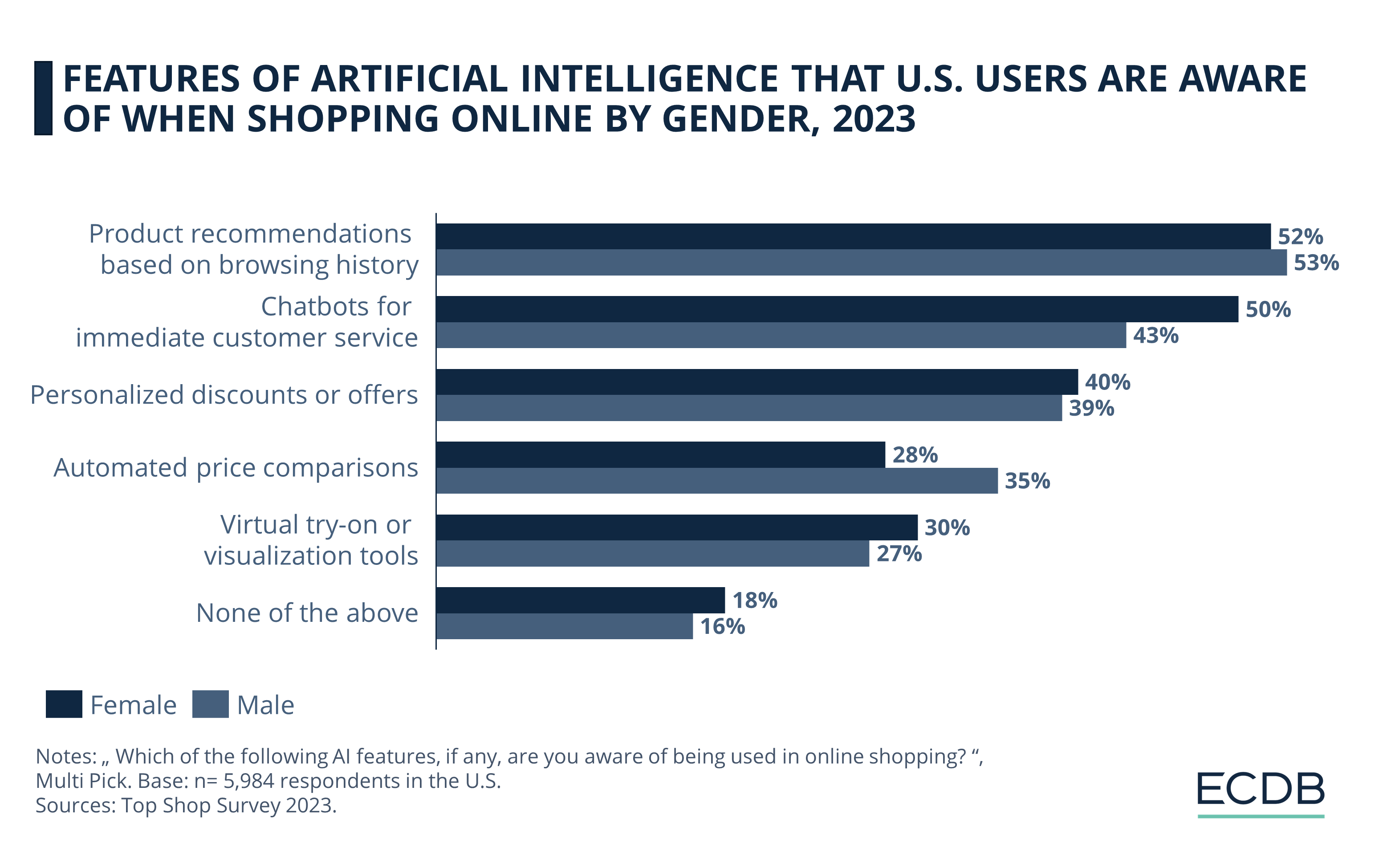
Larger differences are found in the awareness of chatbots for customer service, which half (50%) of female users are conscious of, compared to 43% of male shoppers.
Male consumers, on the other hand, are more likely to have heard of automated price comparisons, with 35%, against 28% of female users.
Age: Product Recommendations and Chatbots Remain Most Widely Known
Across all age groups, awareness remains largely consistent, with only a few variations. Overall, product recommendations based on browsing history remain the best known among consumers regardless of age.
However, for consumers over the age of 54, personalized product recommendations and customer service chatbots are very similar in terms of awareness, at 25% for the former and between 22% and 24% for the latter. This is also true for the youngest age group, 18- to 20-year-olds, where 22% are aware of product recommendations and 21% of customer service chatbots.
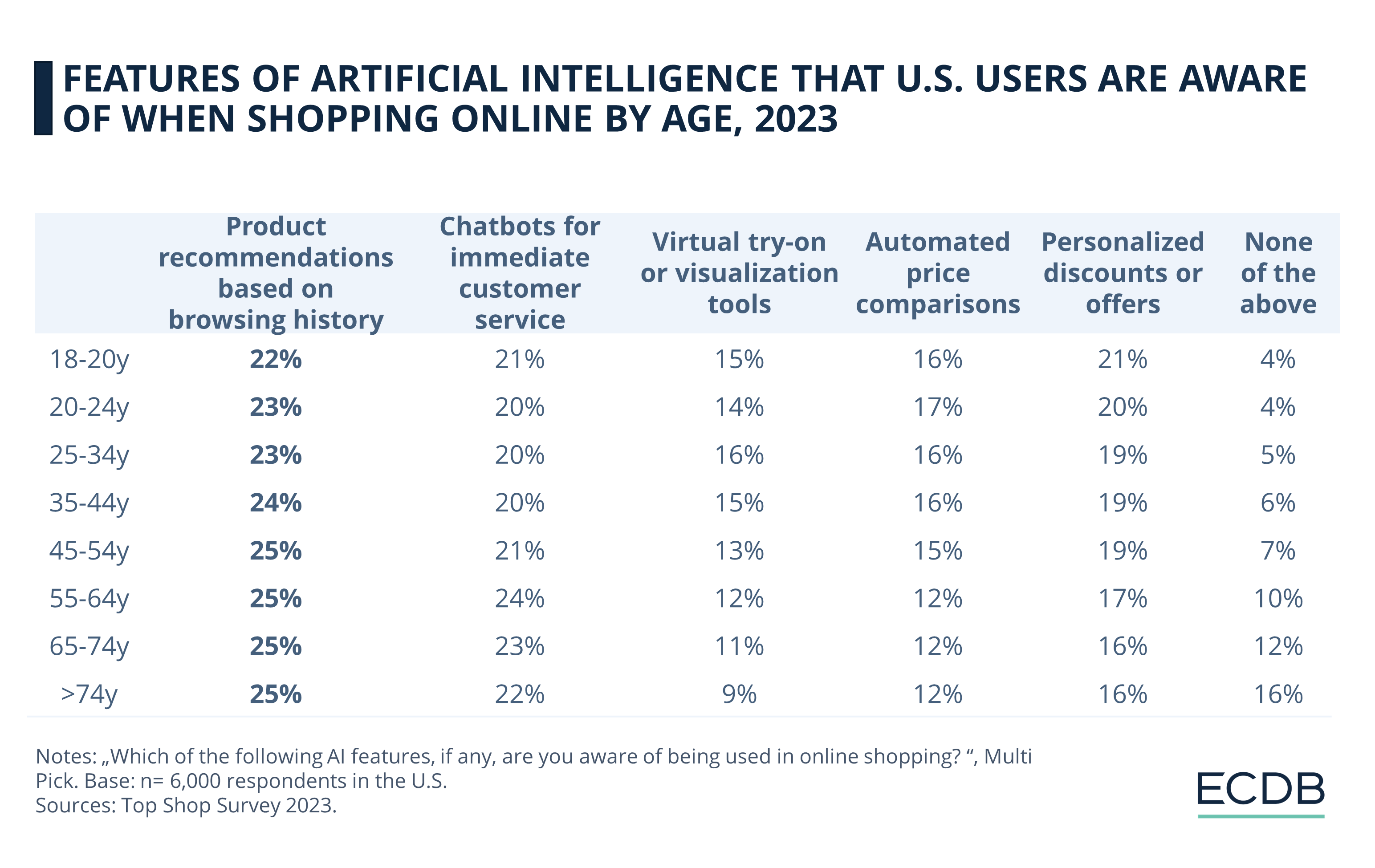
While product recommendations and customer service chatbots are positively correlated with age, meaning that older respondents are more likely to be aware of them, the remaining AI features are better known among younger cohorts.
More specifically, virtual try-on or visualization tools peak in awareness among 25- to 34-year-olds at 16%, and are progressively less known among older users, with the lowest share among users over 74 years (9%). Automated price comparisons show a more linear correlation, but a smaller variance between the highest percentage (17% of 20- to 24-year-olds) and the lowest percentage (12% of users older than 54 years).
Awareness of AI features in generating personalized discounts is linearly correlated, starting at 21% of 18- to 20-year-olds and reaching 16% of users aged over 74.
Finally, not selecting any of the above options is most common among the oldest respondents over 74 years (16%) and least likely among younger users under 24 years (4%).

U.S. Consumer Attitudes Toward AI in eCommerce: Closing Thoughts
Statista's Top Shop survey reflects a largely passive consumer attitude toward AI in eCommerce, characterized by neutral to moderate expectations. While AI has long been used to refine algorithms and improve data analytics, its mainstream introduction has sparked increased adoption and development, with many new players jumping on the bandwagon. Despite this, consumers are not necessarily aware of how AI is being implemented in the online shopping experience. As awareness grows, consumer attitudes may change for the better or for the worse.
Currently, the primary consumer concern across demographics pertains to privacy and data security. In terms of the remaining variables, however, demographic relations were mainly not linear, suggesting prevailing individual viewpoints and attitudes that influence each cohort's results.

Click here for
more relevant insights from
our partner Mastercard.
Related insights
Deep Dive
Next Generation eCommerce: Key Trends Shaping the New Age of Online Retail
Next Generation eCommerce: Key Trends Shaping the New Age of Online Retail
Deep Dive
Google's AI Project Jarvis Could Change Online Shopping
Google's AI Project Jarvis Could Change Online Shopping
Deep Dive
The Customer Journey in Online Shopping: It Begins with Search Engines
The Customer Journey in Online Shopping: It Begins with Search Engines
Deep Dive
TikTok Shop Expands Operation in the United States
TikTok Shop Expands Operation in the United States
Deep Dive
Fast Fashion Online Market: Fast Fashion Is Not Fair Fashion
Fast Fashion Online Market: Fast Fashion Is Not Fair Fashion
Back to main topics
